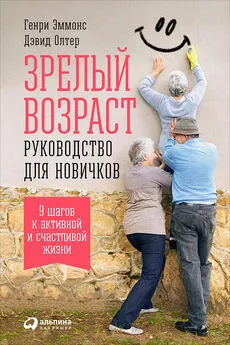Генри Эммонс - Зрелый возраст
- Название:Зрелый возраст
- Автор:
- Жанр:
- Издательство:Альпина Паблишер
- Год:2016
- Город:Москва
- ISBN:978-5-9614-5698-1
- Рейтинг:
- Избранное:Добавить в избранное
-
Отзывы:
-
Ваша оценка:
Генри Эммонс - Зрелый возраст краткое содержание
Наш мозг в зрелом возрасте не только не увядает, но и сохраняет способность учиться и развиваться — это доказанный современной наукой факт. Интересная, активная и здоровая старость, о которой мечтает каждый, сегодня вполне достижима. Практикующий психотерапевт Генри Эммонс и нейропсихолог Дэвид Олтер рассказывают об уникальных методах оздоровления мозга, упражнениях на остроту ума и о правилах, следуя которым вы будете встречать каждый новый день с радостью. Из книги вы узнаете: как физическая нагрузка влияет на здоровье мозга, эмоции и энергичность; как решать проблемы со сном; как правильное питание действуют на работу мозга; как настроить себя на позитивный лад и о многих других способах, которые позволят в преклонном возрасте быть активными и счастливыми.
Зрелый возраст - читать онлайн бесплатно ознакомительный отрывок
Интервал:
Закладка:
196. A. Schore, “Paradigm Shift: The Right Brain and the Relational Unconscious,” American Psychological Association, invited speaker, lecture conducted for Plenary Session at the American Psychological Association Annual Convention, Toronto, Canada, Aug. 8,2009.
197. A. Schore, “Effects of a Secure Attachment Relationship.”
198. A. Schore, “Attachment and Regulation of the Right Brain.”
199. A. Schore, “Paradigm Shift.”
200. W.A. Collins and L.A. Sroufe, “Capacity for Intimate Relationships: A Developmental Construction,” in W. Furman, B.B. Brown, and C. Feiring, eds., The Development of Romantic Relationships in Adolescence (New York: Cambridge University Press, 1999).
201. М. Solomon, “Emotion in Romantic Partners: Intimacy Found, Intimacy Lost, Intimacy Reclaimed,” in D. Fosha, D, Siegel, and M. Solomon, eds., The Healing Power of Emotion: Affective Neuroscience, Development and Clinical Practice (New York: W.W. Norton, 2009).
202. M. Lucas, Rewire Your Brain for Love: Creating Vibrant Relationships Using the Science of Mindfulness (Carlsbad, CA: Hay House Publishing, 2012).
203. J. Sze et al., “Greater Emotional Empathy and Prosocial Behavior in Late Life," Emotion 12, no. 5 (2012): 1129-40.
204. R. Levenson, “Emotion and Emotion Regulation," in Changing Emotions, ed. D. Hermans, B. Rime, and B. Mesquita (New York: Psychology Press, 2013), 105-12.
205. G. Labouvie-Vief, Psyche and Eros: Mind and Gender in The Life Course (New York: Cambridge University Press, 1995).
206. B. Kok et al., “How Positive Emotions Build Physical Health: Perceived Positive Social Connections Account for Upward Spiral between Positive Emotions and Vagal Tone,” Psychological Science 24, no. 7 (2013): 1123-32.
207. C.D. Batson et al., eds., “Empathy and Altruism,” Oxford Handbook of Positive Psychology, 2nd ed. (New York: Oxford University Press, 2009).
208. B. Schwartz, Rippling: How Social Entrepreneurs Spread Innovation throughout the World (New York: John Wiley & Sons, 2012).
209. T. Hacker, “Building Empathy Builds Society,” The Seattle Times, Jan. 28, 2013.
210. J. Eakin, Living Autobiographically: How We Create Identity in Narrative (Ithaca: Cornell University Press, 2008).
211. P. Eriksson and L. Wallin, “Functional Consequences of Stress-Related Suppression of Adult Hippocampal Neurogenesis: A Novel Hypothesis on the Neurobiology of Burnout,” Acta Neurologica Scandinavia 110, no. 5 (2004): 275-80.
212. J.D. Bremner, Does Stress Damage the Brain? (New York: W.W. Norton & Co.,
2002).
213. M. Crockett et al., “Serotonin Selectively Influences Moral Judgment and Behavior through Effects on Harm Aversion," Proceedings of The National Academy of Sciences 107, no. 40 (2010), retrieved May 19, 2014, doi:10.1073/ pnas.1009396107.
214. J.T. Cacioppo et al., “Social Neuroscience: Progress and Implications for Mental Health,” Perspectives on Psychological Science 2, no. 2 (2007): 99-123.
215. C. Yamal and X. Qian, “Older-Adult playfulness: An Innovative Construct and Measurement for Healthy Aging Research,” American Journal of Play 4, no. 1 (2011): 52-78.
216. E.Y. Cornwell and L.J. Waite, “Social Disconnectedness, Perceived Isolation, and Health among Older Adults,' "Journal of Health and Social Behavior 50, no. 1 (2009): 31-48.
217. T. Schmid, Promoting Health through Creativity: For Professionals in Health, Arts and Education (London, England: Whurr Publishers Ltd., 2005).
218. С. Pasquaretta et al., “Social Networks in Primates: Smart and Tolerant Species Have More Efficient Networks,” Scientific Reports 4, Article number 7600 (Dec. 2014), doi:10.1038/srep07600.
219. К. M. Kendrick, “The Neurobiology of Social Bonds,"Journal of Neuroendocrinology 16. no. 12 (Dec 2004): 1007-8.
220. P.L. Wachtel, Relational Therapy and the Practice of Psychotherapy (New York: Guilford Publishing, 2008).
221. L. Cozolino, The Neuroscience of Human Relationships: Attachment and the Developing Social Brain (New York: W.W. Norton, 2006).
222. D. Wallin, Attachment in Psychotherapy (New York: Guilford Publishing, 2007), 101.
223. L.M. Matire and M.M. Franks, “The Role of Social Networks in Adult Health: Introduction to the Special Issue,” Health Psychology 33, no. 6 (2014), 501-4.
224. J.K. Kiecolt-Glaser and T.L. Newton, “Marriage and Health: His and Hers.” Psychological Bulletin 127 (2001): 472-503.
225. M.M. Franks et al., “I Will If You Will: Similarity in Health Behavior Change of Married Partners,” Health Education and Behavior 39 (2012): 324-31.
226. R.S. Sneed, and S. Cohen, “Negative Social Interactions and Incident Hypertension among Older Adults," Health Psychology 33 (2014): 554-65.
227. S.T. Cheng et al., “Physical and Social Activities Mediate the Associations between Social Network Types and Ventilator Function in Chinese Older Adults,” Health Psychology 33 (2014): 524-34.
228. J. Hollis, The Eden Project: In Search of the Magical Other (Toronto: Inner City Books, 1998), 13.
229. C.J. Jung, “Commentary on ‘The Secret of the Golden Flower,’" in Collected Works, vol.13. Alchemical Studies (UK: Routledge & Kegan Paul, 1967), 47-48.
230. U.S. Department of Health and Human Services, “Prevention Makes Common ‘Cents’ ”: http://aspe.hhs.gov/health/prevention/prevention.pdf(2003).
231. A. Golay et al., “Motivating for Change: A New Approach,” Service of Therapeutic Educationfor Chronic Diseases, Didactic Science Laboratory, Geneva, Switzerland, 2012 .
232. N.L. Kerr and C.M. Kaufman-Gililand, “Communication, Commitment, and Cooperation in Social Dilemma,” Journal of Personality and Social Psychology 66. no. 3 (1994): 513-29.
233. K.M. Brethel-Haurwitz and A. A. Marsh, Geographical Differences in Subjective Well-Being Predict Extraordinary Altruism, Psychological Science 25, no. 3 (2014): 762-71.
234. V.E. Frankl, The Unheard Cry for Meaning: Psychotherapy and Humanism (New York: Simon & Schuster, 1978).
235. M. Freedman, Encore: Finding Work That Matters in the Second Half of Life (New York: Perseus Books Group, 2007).
236. W. Muller, How, Then, Shall We Live? (New York: Bantam, 1996).
237. M. Buber, I and Thou (New York: Charles Scribner’s Sons, 1970).
238. E. Renehan et al., “Healthy Aging Literature Review,” National Ageing Research Institute and Council on the Ageing, 2012, prepared for the Victoria, Australia, Department of Health, www.health.vic.gov.au/agedcare.
239. B. Cornwell, E.O. Laumann, and L.P. Schumm, “The Social Connectedness of Older Adults: A National Profile,” American Sociological Review 73, no. 2 (2008): 185-203.
240. Quoted from “Addressing Isolation among Older Adults: The Role of Social Connectedness in Healthy Aging,” report of The National Council on Aging, 2014, www.illuminage.com/webinars/presentations/webinar-052214.pdf.
241. C. A. Emlet and J.T. Moceri, “The Importance of Social Connectedness in Building Age-Friendly Communities,” Jowrra/ of Aging Research 2012, article ID173247,9 pages, http://dx.doiorg/10.1155/2012/173247.
242. V. Toepoel, “Aging, Leisure, and Social Connectedness: How Could Leisure Help Reduce Social Isolation of Older People?” Social Indicators Research 113 (2013): 355-72.
243. D. Whyte, Everything Is Waitingfor You (Langley, WA: Many Rivers Press, 2003).
244. http://rabbidavidkominsky.com/tag/zusya/. Used with permission.
245. P. Palmer, Let Your Life Speak: Listening to the Voice of Vocation (New York: John Wiley & Sons, 2000).
246. Там же.
247. P. Nelson, There's A Hole in My Sidewalk (Hillsboro, OR: Beyond Words, 1993).
248. M. Oliver, “When Death Comes,” New and Selected Poems (Boston: Beacon Press, 2004).
249. S. Haldeman-Martz, ed., If I Had My Life to Live Over, I Would Pick More Daisies (Watsonville, CA: Papier-Mache Press, 2010).
250. W. Muller, A Life of Being, Having, and Doing Enough (New York: Harmony, 2011).
Примечания
1
Пер. С. Ильина.
2
Пер. Д. Кузнецова.
3
Канеман Д. Думай медленно... Решай быстро. — М.: ACT, 2013.
4
Дахигг Ч. Сила привычки. Почему мы живем и работаем именно так, а не иначе. — М.: Карьера Пресс, 2012.
5
Пер. А. Федорова.
6
Бубер М. Я и Ты. — М.: Республика, 1995.
Интервал:
Закладка:








